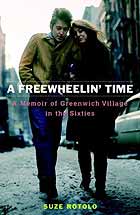"He would play with some guy called Mark Spoelstra. And Mark Spoelstra had lovely shoulders..."
But it was Dylan's harmonica-playing that ultimately proved to be more of a magnet than Spoelstra's shoulders...
"When I met Dylan, what I loved about him was the way he played the harmonica... He played with an earthiness that was wonderful..."
From time to time, Susan and Dylan would run into each other at parties. At a get-together after a day-long hootenanny at Riverside Church in July, at which Dylan had performed, Susan remembers,
"I really got to know Dylan more. We were kind of flirting with each other..."
Then, it seems, all of a sudden they were a couple... Eventually, Susan and Dylan took an apartment together on West Fourth Street.
Victoria Balfour, Rock Wives -- Susan Rotolo: Bob Dylan, reprinted in Elizabeth Thomson & David Gutman, The Dylan Companion, London, 1991, pp. 73-75.
In mid-December 1961... Dylan moved into his first rented apartment, a tiny, scruffy place above Bruno's Spaghetti Shop [161 West Fourth Street], and persuaded his girlfriend, Suze Rotolo, to move in with him.
It was in the middle of West Fourth Street, in February 1963, that Dylan and Suze, together again after seven months' separation, were photographed in the snow for the cover of "The Freewheelin' Bob Dylan" by Columbia staff photographer Don Hunstein...
John Bauldie, Positively 4th Street Revisited, Q, No. 104, May 1995, p. 57.
Sitting in a cafe in New York's East Village, where she now lives, Rotolo laughs at the pitfalls of memory. She and the photographer, she says, recently disagreed on exactly where they were on that cold February day in 1963. A few shots had been taken in the West 4th Street apartment she shared with Dylan. Then they all went outside, into the snow. Dylan, conscious of being in the process of creating an image for himself, pulled on a thin suede jerkin and shivered. Rotolo chose a thick sweater and a favourite loden-green winter coat, more suited to the conditions. Wrapped around each other, they walked through the slush towards the camera. Hunstein says they were on Cornelia Street. Rotolo is convinced it was Jones Street, one block closer to the apartment. "So that's just going to have to remain a mystery for all those Dylanologists," she says, with a note of mischievous delight.
Richard Williams, Tomorrow Is A Long Time, The Guardian, August 16, 2008.
Former Greenbriar Boy John Herald reflects on that historical cover:
"It really captured the mood of the time. We all had girlfriends. We all felt that spirit."
Songwriter Carol Belsky describes the effect the cover had on her:
"Suze was the epitome of everything that was hip. I wanted to recreate the essence of that album cover. I wanted to dress like her and look like her. I wanted to be Susan Rotolo. That cover was the symbol of my generation, the free-spirited freedom."
Susan was a seventeen-year-old product of a cultured. left-wing, political family. She was... very familiar with the Village scene, because she had been hanging around there since her early teens. Susan was living in the Village with her older sister, Carla, when she began dating Dylan.
Robbie Woliver, Hoot! A 25-Year History of the Greenwich Village Music Scene, New York, NY, 1986, p. 73.
SUSAN ROTOLO:
People say I was an influence on him, but we influenced each other. His interests were filtered through me and my interests, like the books I had, were filtered through him. There was a book of satirical cartoons from the Depression by Art Young that I showed him. It was during that time he was beginning to write his songs. It was wonderful satire.
My interest in Brecht was certainly an influence on him. I was working for the Circle in the Square Theatre and he came to listen all the time. He was very affected by the song that Lotte Lenya's known for, "Pirate Jenny."
It was always sincere on his part. He saw something. The guy saw things. He was definitely way, way ahead. His radar was flying. He had an incredible ability to see and sponge -- there was a genius in that. The ability to create out of everything that's flying around. To synthesize it. To put it in words and music. It was not an intellectual approach that he had to research something -- he did it on his own. Quoted ibid., pp. 75-76.
LINKS:
Suze Rotolo Homepage
"Bob Dylan's Muse Suze Rotolo Dies"
(BBC, February 28, 2011)
Two interview video clips for BBC's "Folk America" (BBC, 2009):
Suze Rotolo, Bob Dylan's girlfriend in the early 60s, recalls watching him in the studio and the photo session that resulted in the famous Freewheelin' album cover.
Suze Rotolo talks candidly about her relationship with Bob Dylan, being his "muse" and watching him create his early work.
NOTE:
For legal reasons, video clips are only available to persons from the UK/with a UK IP address.
Suze Rotolo Obituary,
The Guardian, February 28, 2011
"Bob Dylan's Muse: Suze Rotolo, 1943-2011"
Recordmecca, February, 28, 2011
(contains scans of two blues albums owned and annotated by Bob Dylan, plus the scan of a postcard sent from Italy where Bob mentions that he is learning the Italian song "Se Dio Vorra")
Richard Williams, "Tomorrow is a long time",
The Guardian, August 16, 2008
(contains a 09:31 telephone interview with Suze Rotolo)
"In Praise of... A Freewheelin' Time",
The Guardian, March 02, 2011
David Chiu, "A quintessential 1960s Greenwich Village Romance",
The Villager, May 21-28, 2008
"Suze Rotolo: Of Dylan, New York and Art"
Fresh Air, WHYY, NPR, May 14, 2008
"Remembering Suze Rotolo, Dylan's 'Freewheeling' Muse"
Fresh Air, WHYY, NPR, March 01, 2011
Suze Rotolo, 1943-2011
(The Village Voice)
Howard Fishman, "The main thing is you are your own self"
Frank Beacham, "The Death of Suze Rotolo"
Numerous audio clips of Suze Rotolo
at Bob Dylan's American Journey, 1956-1966





Keine Kommentare:
Kommentar veröffentlichen